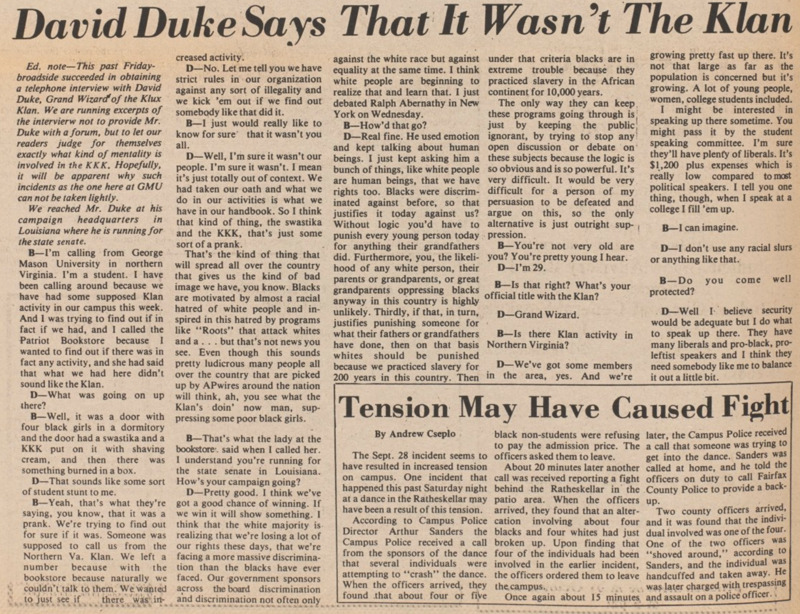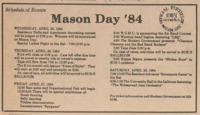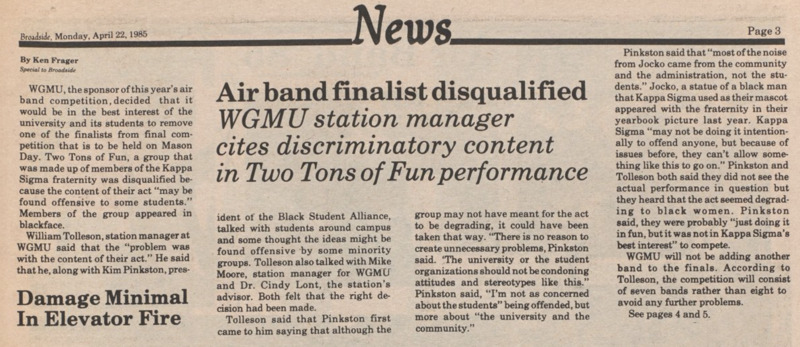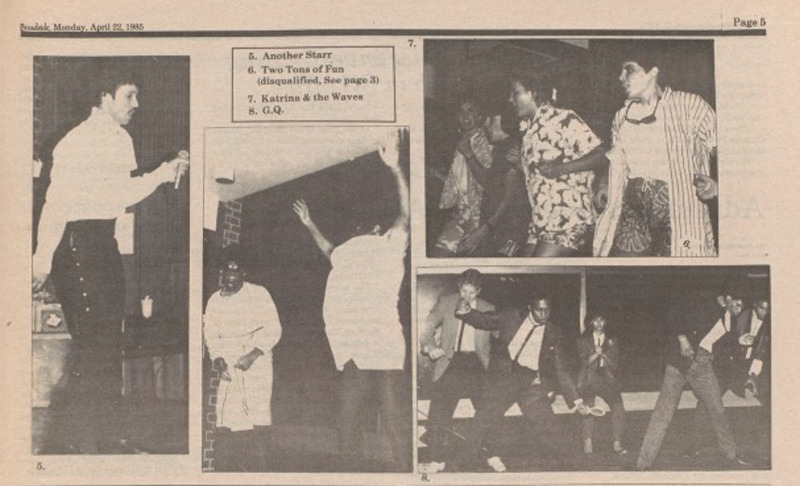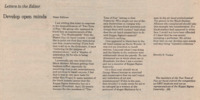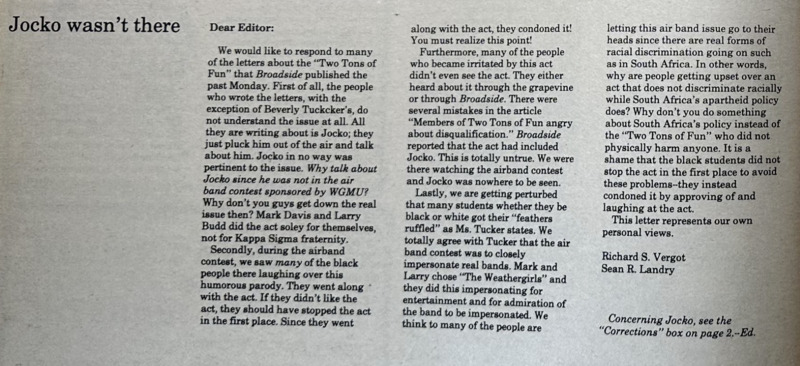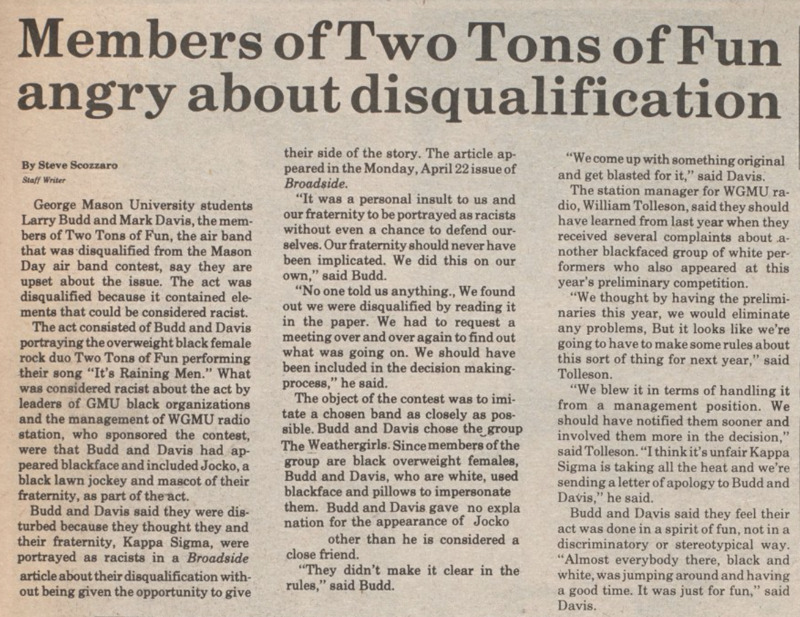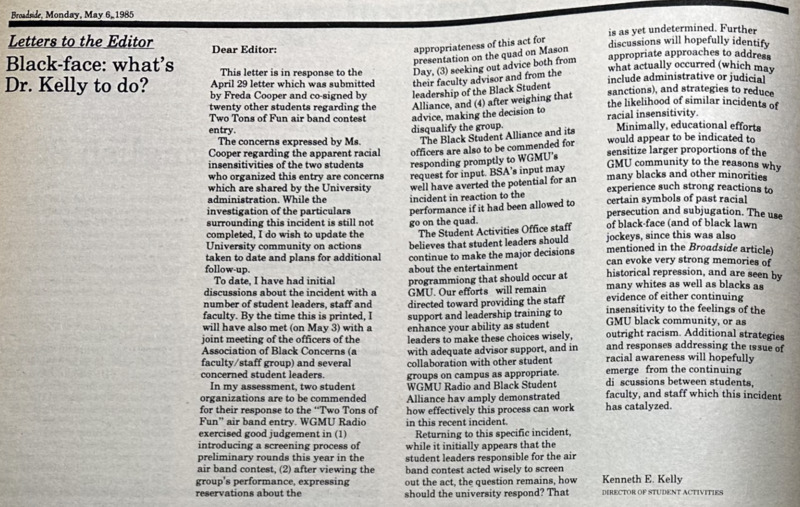1980s and 1990s: The KKK, Mason Days, and Derby Days
While some GMU students had at least become aware of the situation of implicitly accepted racial hegemony perpetuated at the university, and pressure from outside forces had started changes at the University, the attempts to ameliorate issues were not strong enough to rapidly fix the problems. The culture of racial ridicule, and racist structures were imbedded both in the institution and in the locale. This is represented by the multiple different racist events that popped up during the 1970s, even after some students showed awareness of racial disparities and racial inequalities at the university. While “Slave Day” at the university seems to have died out with its last recorded appearance in 1973, the culture likely persisted. The history of slave sales, black face, and racist caricatures on campus going back to the 1960s, and appearing through the 1970s shows this. The drawing of Klan and Nazi symbols on the door of four Black female GMU students’ apartment housed on campus in late 1979 marks a visible revival of outwardly racist actions on campus. During the next decade and reaching into the early 1990s, a string of racially ridiculing incidents acts as a reminder of the history of race relations, and racial ridicule in both Northern Virginia and at GMU.
Following an investigation by campus and local police into the 1979 KKK and Nazi markings, no suspects were found. It is important to add some context to this event. At the time David Duke’s revanchist KKK movement in Louisiana had gained fame throughout the south. After this incident occurred, the GMU campus newspaper “Broadside” reached out to the then Grand Wizard of the KKK, David Duke. In the interview Duke claimed that this was not something his people would do.[1] When asked if there was any Klan activity in Northern Virginia, Duke responded, “We’ve got some member in the area, yes. And we’re growing pretty fast up there. It’s not that large as far as the population is concerned but it’s growing. A lot of young people, women, college students included.”[2] This begs the question whether the revivalist movement of the KKK could instigate racial backlash after a decade and a half of attempts at desegregation, affirmative action, and civil rights legislation. It’s hard to know, as no suspects were ever officially caught or reprimanded, however, this occurrence ushers in three specific events during the next decade and a half.
The 1985 blackface incident at the WGMU Air Band Contest marks the second of three incidents. Performing in blackface, dressing as women, and wearing dresses with the large bodily proportions typical of caricatures and stereotypes of Black women, the two members of the air band “Two Tons of Fun”, previously the name of The Weather Girls, danced to the aforementioned band’s song “It’s Raining Men.”[3] The two student performers, Larry Budd and Mark Davis of the Kappa Sigma fraternity, were pictured in Broadside the week following where it’s plain to see their harmful caricature of Black women during their performance.[4] Unsure about the performance’s potential to be seen as racially insensitive, WGMU station manager William Tolleson, and president of the Black Student Alliance Kim Pinkston met with students, Mike Moore of WGMU, station advisor Dr. Cindy Loft and decided to disqualify Budd and Davis’s act from the running.[5]
Responses from the mostly white student body demonstrate the complete lack of understanding as to what blackface performances mean, and the racist history and racial insensitivity of it. Instead of condemning they deflected by stating Black students at the event found humor in the act, and therefore they condoned blackface. In one case a student, Beverly Tucker, even admits to being a contestant in the WGMU sponsored contest, and performing in blackface as Stevie Wonder.[6] Tucker goes on to state “The person in the Black student Alliance who complained should take this example into consideration. If a black student had appeared in white face, I wouldn’t have been offended if I knew he was merely imitating a performer. My advice from here on out: develop open minds and stop being ‘injustice collectors.’”[7] This is only one of many responses sent by students that take a certain tone of hostility, while seeking to defend Budd and Davis, or treat the event with levity instead of condoning it.
The first of three incidents took place on April 27th 1984 at Mason Day ‘84.[8] This is the first of two Mason Day incidents, the second occurring the following year in a similar fashion. As part of the Mason Day festivities, WGMU the campus radio station, would sponsor an “Air Band Contest”. The goal of this was for students to dress up, either impersonating the band or performing in another costume, and dance/perform to the song as an “air band”. According to reporting from 1985, a group of white students performed in Black face, which WGMU station manager William Tolleson stated they received several complaints about. Reporting on this incident is scant, no mentions of this go beyond Broadside -the school newspaper – advertising the Air Band Contest the week before.[9] Only until the same incident happened again a year later is this mentioned, although with similar lack of reporting.[10]
Another letter to the editor from two students, Richard Vergot and Sean Landry, demonstrates a clear lack of understanding of the damaging nature of blackface performances, and what counts as discrimination. Titled “Jocko wasn’t there”, the letter first touches upon the reporting from April 22 that noted the Kappa Sigma fraternity’s mascot, a Black lawn jockey named Jocko, was brought along to the performance by Budd and Davis.[11] While Broadside did correct their report on this, to state Jocko was not in attendance, it is worth noting the importance of Jocko as a mascot for Kappa Sigma.
The history of lawn jockeys is one of racist caricatures, used as decorative yard ornaments, or as mailboxes, these jockeys represent another piece of the racist history in America and the South. Consider too, that Kappa Sigma colonized the Delta Tau Sigma in 1970, as discussed in the 1950s and 1960s section of this research. The relation between these two creates a clear link between the early period of GMU’s history of slave sales, and racial ridicule, linking the older era to the 1980s and the apparent revival of this culture.
Continuing on with the letter to the editor, the student then goes on to attack students who feel that Budd and Davis’ performance was out of line or racist, agreeing with Beverly Tucker that students are too sensitive now, and instead they should focus on "real discrimination", instead of complaining about an “impersonat[ion] for entertainment and admiration of the band…”:
“We think to many of the people are letting this air band issue go to their heads since there are real forms of racial discrimination going on such as in South Africa. In other words, why are people getting upset over an act that does not discriminate racially while South Africa's apartheid policy does? Why don't you do something about South Africa's policy instead of the ''Two Tons of Fun" who did not physically harm anyone. It is a shame that the black students did not stop the act in the first place to avoid these problems-they instead condoned it by approving of and laughing at the act.
This letter represents our own personal views.”[12]
Director of Student Activities, Kenneth Kelly’s letter to the editor provided important clarity from the administration. However, it is unclear whether further actions were taken in regards to the students, Budd and Davis, or whether further changes were brought forward. In total, their letter provides a certain level of maturity, and acute awareness of the problem of racism, the harmful caricatures of Jocko and “Two Tons of Fun”, along with the potential marks these incidents leave on the university and the student.[13] However, this does not mark the end of these outbursts of racism on campus. While no clear occurrences happened for the next 5 years, April 1991 would bring forth one final and loud example of racial ridicule on campus in the 20th century.
[1] “David Duke Says That It Wasn’t The Klan,” Broadside, October 10, 1979.
[2] Ibid.
[3] Ibid.
[4] Photos by Ken Frager and Eddie Maloney, “6. Two Tons of Fun (Disqualified, See Page 3),” Broadside, April 22, 1985, sec. Air Band ’85 [photographs].
[5] Ken Frager, “Air Band Finalist Disqualified,” Broadside, April 22, 1985.
[6] Beverly S. Tucker, “Develop Open Minds,” Broadside, April 29, 1985, sec. Letters to the Editor.
[7] Ibid.
[8] Steve Scozzaro, “Members of Two Tons of Fun Angry about Disqualification,” Broadside, April 29, 1985 – Mentioned briefly, see footnote 42.
[9] “Mason Day ’84,” Broadside, April 23, 1984.
[10] Steve Scozzaro, “Members of Two Tons of Fun Angry about Disqualification,” Broadside, April 29, 1985 – Broadside noted “the station manager for WGMU radio, William Tolleson, said they should have learned from last year when they received several complaints about another blackfaced groups of white performers who also appeared at this year’s preliminary competition.”
[11] Richard S. Vergot and Sean R. Landry, “Jocko Wasn’t There,” Broadside, May 6, 1985, sec. Letters to the Editor.

